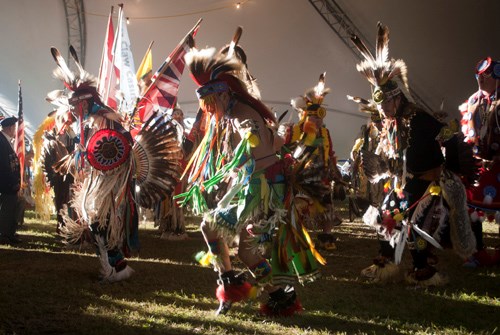As drums were pounded and voices carried through the Moose Mountains, people danced gracefully about as their colourful regalia jingled softly in every movement.
The Summer Celebrations Pow Wow held at the Bear Claw Casino was a great success this year attracting 302 dancers to the celebration.
Dancers came from across North America to the annual event, which sees Golden Age dancers, Senior and Junior dancers as well as Tiny Tots enter for a chance to win cash prizes.
Dances included men's Fancy, Grass, Traditional, and Chicken as well as women's Fancy, Traditional, and Jingle.
The three day event held between July 30 and Aug. 1 boasted a large crowd interested in sharing First Nations' culture.
Announcers Howie Thompson of Carry the Kettle First Nations and Tommy Christian of Fort Peck both entertained the crowd and provided knowledgeable insights to the dances, explaining the importance of each.
Chief Brian Standingready of the White Bear First Nation was pleased to have a large crowd in attendance and thanked everyone for being there for the festivities.
"It's an honour to take part in this evening, to take part in the Grand Entry, to represent not only our people, but those we've lost along the way," Standingready explained.
Dancing at a Pow Wow is a very important aspect of First Nations life according to participants, who were happy to share their dancing with everyone in attendance.
"It's just dance is what I was taught, you dance for your family, who you are, and where you come from," BJ Sanderson of Prince Alberta explained. "You're just out there dancing for the people."
Vee Whitehorse of Pipestone, MB, explained that it is not only important to celebrate their culture and the people, but to pass down a legacy of dance to youth. The hard work involved in learning the different dances as well as the importance of traditional practices to be carried into the future.
"We dance to celebrate life and to support our young people who will carry on our dancing and singing," Whitehorse stated.
This includes the teachings to youth of who they are and where they come from, which is echoed in the beadwork displays of each individual dancer. Their regalia is handmade and tells a story to those able to interpret the message.
"The beadwork retells who comes from a certain tribe and it tells a story in itself."
Whitehorse's story, in short, includes "[his] clan, who [his] grandparents were, and the tribe [he] belongs to."
Both Whitehorse and Sanderson are traditional dancers who travel across the United States and Canada participating in Pow Wows.
"It's always good to travel to different regions, countries, and reserves," Whitebear explained.
A kinship is developed by the dancers who come from different First Nations' groups and all are joined together during Pow Wows to dance for life and in memory of their loved ones, while sharing their culture with people from other walks of life as well.




